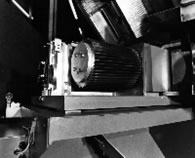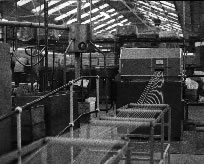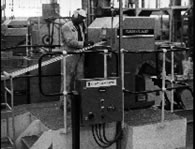Quieter by design - strand pelletisers
The problem

Strand pelletisers are used in the plastics industry to convert continuous strands of plastic into small pellets for use in subsequent manufacturing processes. The most important part of a pelletiser is its cutting head where the plastic strands are fed by rollers into the path of a high-speed, multi-bladed rotating head.
A-weighted noise levels from a pelletiser can exceed 90 dB. Noise is generated by the impact of each blade against the strands and the alternate compression and expansion of air as the moving knives pass the fixed bed knife edge.
The solution

A company manufacturing strand pelletisers has developed a series of new machines which incorporate a number of important noise reducing features.
On examining the cutting operation, it was revealed that the speed of rotation could be reduced by increasing the number of blades fixed into the cutting head. It was found that a helical blade, which would pass progressively across the bed knife edge cutting one strand at a time rather than all simultaneously, would further reduce noise levels. Additional benefits of the helical cutter were found to be reduced wear and a reduced need to sharpen blades.

The machine casing was also redesigned, reducing both mechanical and airborne noise radiation. Anti-vibration treatment was adopted, with the cutting head installed on a base isolated from the rest of the machine.
The cost
About £25 000 for a new pelletiser and about £11 000 to upgrade a conventional pelletiser. (1995)
The result
A noise reduction of at least 10 dB.
Source
Photographs courtesy of John Brown Plastics Machinery Limited. Equipment designed and manufacture by John Brown Plastics Machinery Limited.